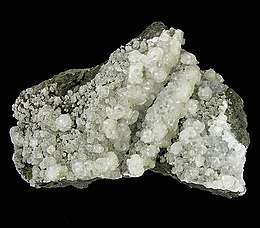Stellerite
Stellerite is a rare mineral discovered by and named after Georg Wilhelm Steller, a German explorer and zoologist.[1] The mineral has a general formula of Ca[Al2Si7O18]·7H2O. Like most rare minerals, there are few commercial uses for stellerite. Mineral collectors are lucky to find it in good enough crystal form. Zeolites, including stellerite, have been studied using a dehydration process to gauge the potential use of their phases as molecular sieves, sorbents, and catalysts.[2]
| Stellerite | |
|---|---|
 | |
| General | |
| Category | Zeolite mineral |
| Formula (repeating unit) | Ca(Al2Si7O18)•7H20 |
| Strunz classification | 9.GE.15 |
| Crystal system | Orthorhombic |
| Crystal class | Dipyramidal (mmm) H-M symbol: (2/m 2/m 2/m) |
| Space group | Fmmm |
| Identification | |
| Color | Colorless to white, pink, orange |
| Crystal habit | Spherical, Stellate, Tabular |
| Cleavage | Perfect on {010} |
| Fracture | Uneven |
| Mohs scale hardness | 4.5 |
| Luster | Pearly |
| Streak | white |
| Diaphaneity | Transparent to translucent |
| Specific gravity | approximately 2.2 |
| Density | 2.13 g/cm3 |
| Optical properties | Biaxial (-), a=1.4848, b=1.4864-1.4964, g=1.4979 |
| Birefringence | δ = 0.013 |
| References | [1] |
Crystal habit
Stellerite is part of the orthorhombic crystal system which means it has three axes of unequal length that intersect at 90° angles. Its crystal class is rhombic-dipyramidal which means it has three perpendicular two-fold rotational axes with perpendicular mirror planes.[3] This would look like a dipyramid cut horizontally along the middle to where the top and bottom halves each have four identical faces that can either be compared to the other faces by the 2-fold rotation axes or the mirror planes.[4] Stilbite, another zeolite, is very similar to stellerite in both chemical composition and physical appearance. Stellerite is more commonly found in rounded radiating clusters or as single crystals and appears more transparent than stilbite does.[3]
Optical properties
Stellerite is an anisotropic mineral, meaning that it has different properties in different directions-such as indices of refraction-when light passes through it. A refractive index (n) measures the speed of light in a substance—or in the case of mineralogy—in a mineral. It is expressed as a ratio of the speed of light in a vacuum to that in a mineral.[5] Stellerite has three indices of refraction because it is a biaxial mineral.
Occurrence
Stellerite lines cavities and fracture surfaces in volcanic rocks altered by hydrothermal solutions. Great examples of Stellerite are on Copper Island, Commander Islands (also discovered by Georg Steller), Bering Sea and at Klichka, Chita region, Siberia, Russia. In the United States, it is located at Ritter Hot Springs, Grant County, Oregon; on Hook Mountain, Rockland County, New York; and at Fanwood, Somerset County, New Jersey. Large crystals have been found in Australia around Gunnedah, New South Wales, and at Harcourt, Dookie, and Corop, Victoria. [6]
References
- Pabst, A. (1939) The Relation of Stellerite and Epidesmine to Stilbite. Mineralogical Magazine, 25, 271-276.
- Arletti, R., Mazzucato, E., and Vezzalini, G. (2006) Influence of dehydration kinetics on T-O-T bridge breaking zeolites with framework type STI The case of stellerite. American Mineralogist, 91, 628-634.
- Miller,S.A., and Taylor, J.C. (1985) Neutron Single Crystal Diffraction Study of an Australian Stellerite Zeolites, 5, 7-10.
- "Archived copy". Archived from the original on 2008-09-19. Retrieved 2009-07-08.CS1 maint: archived copy as title (link). Accessed 2 December 2010
- "Index of Refraction." Encyclopedia Americana. Grolier Online http://ea.grolier.com/article?id=0213810-00 (accessed May 2, 2010)
- http://www.handbookofmineralogy.org/pdfs/stellerite.pdf. Accessed 2 December 2010.